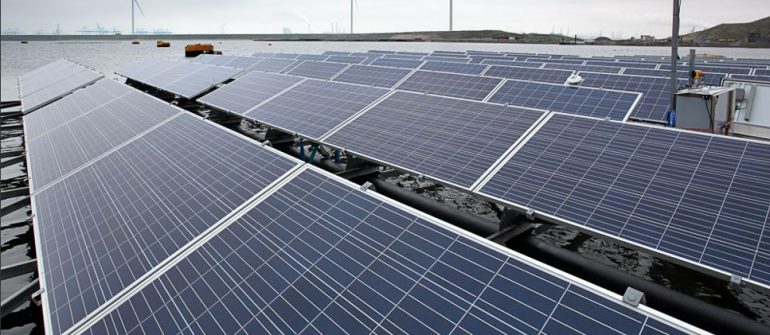Image: TNO
The cooling effect of water in floating PV systems can be increased in tropical and temperate maritime climates if a proper system design allows for more wind to flow between the modules and the water surface. This is one of the main findings of a recent research project conducted by the Netherlands Organisation for Applied Scientific Research (TNO) and the Solar Energy Research Institute of Singapore (SERIS).
Scientists from both organizations have jointly assessed the irradiance-weighted average temperatures (IWATs) of floating solar arrays in the Netherlands and Singapore and have compared the results with those of ground-mounted installations and rooftop PV systems.
The test field in the Netherlands was located on an inland lake close to the sea in the province of South-Holland. The test bed in Singapore was at a 1 MW floating solar array on the Tengeh Reservoir. In the former, two kinds of floating systems were tested: one with a small footprint on water and an open structure (NL1), and one with a large footprint on water and a closed structure (NL2). In the latter, three different systems were investigated: an array with a large footprint and closed structure (SG1), a system with a medium footprint and closed structure (SG2), and a free-standing system with an open structure (SG3).
The performance and temperature behavior of the NL1 and NL2 arrays was compared to those of two reference ground-mounted installations. The scientists called them NL 3 and NL 4. They also compared the energy yield of the three systems in Singapore with the yield from a free-standing rooftop PV system (SG4).
The measurements showed that the irradiance-weighted average temperature (IWAT) of the NL1 system in the Netherlands, which was the best performing system, was 3.2 C lower than the nearby reference system. In Singapore, the best-performing system was the SG3 array, which exhibited a 14.5 C lower IWAT than its reference system. Furthermore, the determined heat loss coefficients of the different systems have been used within PVsyst software to model the annual yield of the floating systems and the reference arrays in a typical meteorological year.
In Singapore, the best-performing system was the SG3 array, which exhibited a 14.5 C lower IWAT than its reference system.
“The determined median heat-loss coefficients of the best-performing systems NL1 and SG3 are with 57 W/m2 per kelvin and 55 W/ m2 per kelvin, respectively, almost identical,” the researchers concluded. “When the heat-loss coefficients of all systems are split into a constant value and a wind-dependent value, and using these values to model the specific yield of all systems, it can be concluded that the largest part of the cooling effect of FPV systems can be attributed to higher wind speeds above water compared to land.”
They also said that the floating systems with the open structure, which allow for wind beneath the modules, can provide a heat loss coefficient that is up to 22 W/m2 per kelvin higher compared to the reference systems.
